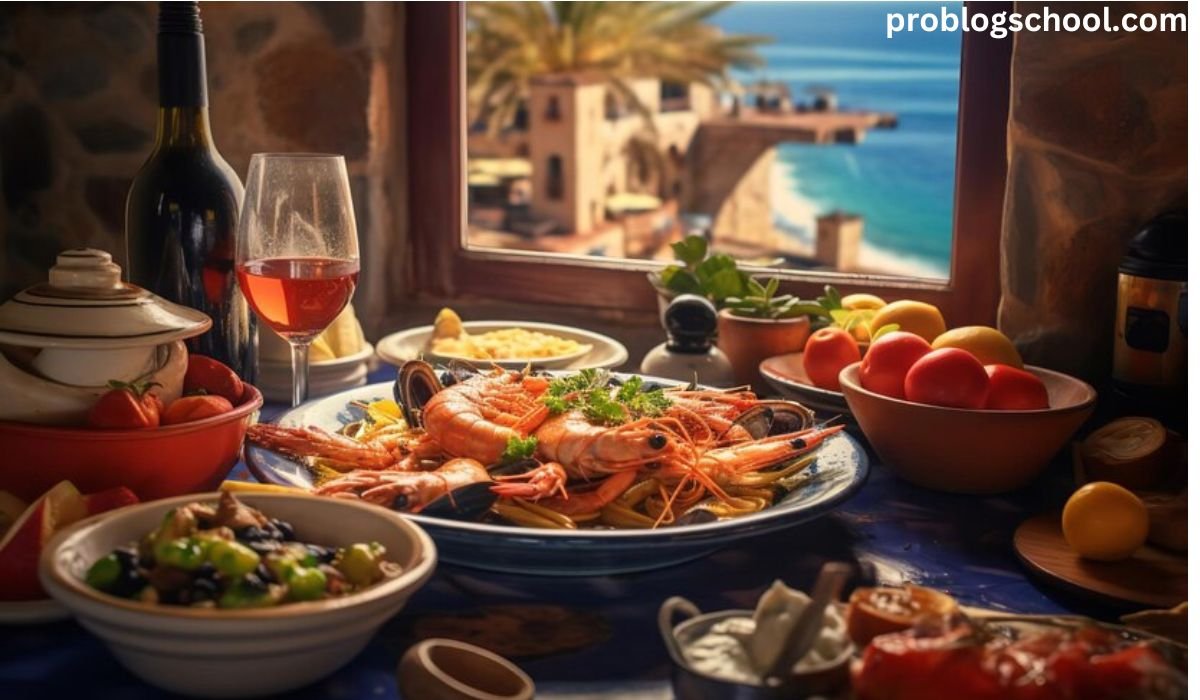Introduction
Calandrando is an emblem of Sicilian culinary tradition, not merely a dish. This unusual meal has been a mainstay in Sicilian kitchens for decades, with its own flavor character and cultural importance. Calandrando, which is steeped in tradition and history, embodies the spirit of Sicilian cooking by combining basic but delectable ingredients to create a meal that is both a feast for the senses and a symbol of the island’s diverse cultural heritage.
Brief Overview of Sicilian Cuisine
Sicilian cuisine is a reflection of the island’s history, geography, and diverse cultural influences. Located at the crossroads of the Mediterranean, Sicily has been shaped by the culinary traditions of Greeks, Romans, Arabs, Normans, and Spaniards, each leaving their mark on the island’s food culture. Sicilian cuisine is characterized by the use of fresh, local ingredients, bold flavors, and a balance between simplicity and sophistication. From fresh seafood and citrus fruits to hearty vegetables and rich pastries, Sicilian dishes are a celebration of the island’s bounty and culinary ingenuity.
Introduction to Calandrando as a Unique Dish
Among the many treasures of Sicilian cuisine, Calandrando stands out as a dish that is both distinctive and deeply rooted in tradition. This dish, often prepared with seasonal ingredients, reflects the essence of Sicilian cooking—simple, flavorful, and steeped in history. Calandrando is not just a meal; it is a culinary experience that offers a taste of Sicily’s past and present.
Thesis Statement
Calandrando is a testament to Sicilian culinary heritage, offering a distinctive flavor profile and cultural significance. This dish encapsulates the essence of Sicilian cuisine, from its historical roots to its place in modern gastronomy.
The Origins of Calandrando
Historical Context of Sicilian Cuisine
To understand Calandrando, one must first appreciate the rich history of Sicilian cuisine. Sicily’s strategic location in the Mediterranean made it a melting pot of cultures, each contributing to the island’s culinary landscape. The Greeks introduced olive oil, wine, and wheat, while the Arabs brought sugar, citrus, rice, and spices. The Normans and Spaniards introduced new cooking techniques and ingredients, enriching the island’s culinary traditions. Calandrando is a product of this diverse cultural heritage, combining ingredients and techniques from various influences to create a dish that is uniquely Sicilian.
The Origins of Calandrando: When, Where, and Why It Was Created
The exact origins of Calandrando are shrouded in mystery, much like many traditional dishes passed down through generations. It is believed to have been created in the rural areas of Sicily, where farmers and peasants relied on locally sourced ingredients to create hearty, nutritious meals. The dish was likely developed as a way to make use of seasonal ingredients, particularly during times of abundance, and has since become a beloved staple in Sicilian households. Over the years, Calandrando has evolved, but it has always remained true to its roots, embodying the simplicity and richness of Sicilian cuisine.
Cultural Significance and Traditions Associated with Calandrando
Calandrando is more than just a dish; it is a symbol of Sicilian identity and culture. It is often prepared during special occasions and family gatherings, where it is shared as a communal meal. The dish is also associated with various Sicilian traditions and customs, such as harvest festivals and religious feasts, where it is served as a celebration of the island’s agricultural bounty. In many Sicilian families, the recipe for Calandrando is passed down from generation to generation, with each family adding their own unique twist to the dish.
The Ingredients of Calandrando
Essential Ingredients: A Detailed Breakdown of Each Component
The beauty of Calandrando lies in its simplicity. The dish typically consists of a few key ingredients, each contributing to its unique flavor profile. These ingredients include:
- Fresh Vegetables: The foundation of Calandrando is a medley of fresh, seasonal vegetables such as tomatoes, eggplants, zucchini, and bell peppers. These vegetables are often roasted or sautéed to bring out their natural sweetness and depth of flavor.
- Olive Oil: A staple in Sicilian cuisine, olive oil is used generously in Calandrando to enhance the flavors of the vegetables and add richness to the dish.
- Herbs and Spices: Fresh herbs like basil, oregano, and parsley are used to season the dish, while spices such as black pepper and red chili flakes add a subtle kick.
- Cheese: Grated pecorino or ricotta salata is often sprinkled on top of the dish before serving, adding a salty, tangy contrast to the sweetness of the vegetables.
- Bread Crumbs: Toasted bread crumbs, known as “muddica” in Sicilian, are sometimes added for texture, giving the dish a satisfying crunch.
Substitutions and Alternatives for Specific Ingredients
While the traditional recipe for Calandrando calls for specific ingredients, there are several substitutions and alternatives that can be used based on availability and personal preference. For instance, if pecorino or ricotta salata is not available, parmesan or feta cheese can be used as a substitute. Similarly, different vegetables can be used depending on the season—artichokes, fennel, or even wild greens can be added to the dish for a different flavor profile.
Seasonal Considerations and Availability of Ingredients
Calandrando is a dish that celebrates the bounty of each season. In the spring and summer, the dish is often made with fresh, vibrant vegetables such as tomatoes, zucchini, and bell peppers. In the fall and winter, heartier vegetables like eggplants, potatoes, and squash are used. The availability of ingredients plays a significant role in the preparation of Calandrando, with the dish evolving to reflect the flavors of each season.
The Preparation Process
Step-by-Step Guide to Making Calandrando
Making Calandrando is a simple yet rewarding process. Here’s a step-by-step guide to preparing this traditional Sicilian dish:
- Prepare the Vegetables: Start by washing and chopping the vegetables into bite-sized pieces. If using eggplants, sprinkle them with salt and let them sit for 30 minutes to remove any bitterness.
- Cook the Vegetables: In a large skillet, heat a generous amount of olive oil over medium heat. Add the vegetables, starting with the ones that take the longest to cook, such as eggplants and bell peppers. Sauté the vegetables until they are tender and lightly caramelized.
- Season the Dish: Once the vegetables are cooked, add fresh herbs, salt, pepper, and any other spices you prefer. Stir to combine and let the flavors meld together.
- Add Cheese and Bread Crumbs: Before serving, sprinkle the dish with grated cheese and toasted bread crumbs for added flavor and texture.
- Serve: Calandrando can be served hot or at room temperature, making it a versatile dish for any occasion.
Tips and Tricks for Achieving the Perfect Texture and Flavor
- Use Fresh Ingredients: The quality of the ingredients is crucial in Calandrando. Always use the freshest vegetables, herbs, and cheese to ensure the best flavor.
- Don’t Rush the Cooking Process: Allow the vegetables to cook slowly over medium heat, so they develop a deep, caramelized flavor. Rushing the process can result in undercooked or burnt vegetables.
- Experiment with Herbs and Spices: Feel free to experiment with different herbs and spices to suit your taste. Adding a pinch of red chili flakes or a dash of balsamic vinegar can elevate the dish’s flavor profile.
Variations and Regional Differences in Preparation
Like many traditional dishes, Calandrando has regional variations across Sicily. In some areas, the dish is prepared with a tomato sauce base, while in others, it is made with a combination of vegetables and legumes. Some variations include seafood, such as anchovies or squid, adding a coastal twist to the dish. Regardless of the variation, Calandrando remains a beloved dish that reflects the diversity and creativity of Sicilian cuisine.
The Flavor Profile of Calandrando
Unique Flavor Combinations and Balance
The flavor profile of Calandrando is a harmonious balance of sweet, savory, and tangy notes. The roasted vegetables bring out the natural sweetness, while the olive oil adds richness and depth. The herbs and spices enhance the dish’s overall flavor, adding a fresh and aromatic quality. The cheese and bread crumbs provide a salty, crunchy contrast, creating a dish that is both satisfying and complex.
The Role of Spices and Herbs in Enhancing the Taste
Herbs and spices play a crucial role in Calandrando, elevating the dish from simple to extraordinary. Fresh basil and oregano add a fragrant, herbal note, while black pepper and red chili flakes bring a subtle heat. These seasonings are carefully balanced to complement the vegetables without overpowering them, resulting in a dish that is flavorful yet refined.
How Calandrando Compares to Other Sicilian Dishes
While Calandrando shares similarities with other Sicilian vegetable dishes, such as caponata or peperonata, it stands out for its simplicity and focus on seasonal ingredients. Unlike caponata, which is a sweet and sour eggplant dish cooked in a rich tomato sauce, Calandrando is lighter and more versatile, allowing the natural flavors of the vegetables to shine through. This makes it a perfect accompaniment to a variety of meals, from casual lunches to elaborate feasts.
Calandrando in Modern Cuisine
Contemporary Interpretations of Calandrando
In recent years, Calandrando has seen a resurgence in popularity, with chefs and home cooks alike experimenting with contemporary interpretations of the dish. Some modern versions incorporate ingredients like quinoa or couscous, adding a new texture and flavor dimension. Others may feature a deconstructed version of the dish, with each component served separately to highlight its individual flavors.
Fusion Cuisine and Innovative Uses of the Dish
Calandrando has also found its way into fusion cuisine, where it is combined with elements from other culinary traditions. For example, Calandrando can be used as a filling for wraps or flatbreads, or as a topping for pizzas and bruschettas. These innovative uses of the dish showcase its versatility and appeal to a global audience.
Calandrando’s Place in the Global Culinary Landscape
As interest in Mediterranean and plant-based diets continues to grow, Calandrando has gained recognition beyond Sicily’s borders. Its emphasis on fresh, wholesome ingredients and bold flavors aligns with contemporary culinary trends, making it a dish that resonates with modern palates. Whether enjoyed in its traditional form or as part of a fusion dish, Calandrando continues to be a beloved representation of Sicilian cuisine on the global stage.
You May Also Like: Süberlig: Uncovering the Nutritional Benefits of a Cultural Dish
Conclusion
To sum up, calderando is a meal that perfectly captures Sicily’s rich culinary history. Calandrando is still a representation of Sicilian culture and heritage, despite its modest beginnings and contemporary adaptations. Its distinct taste profile, ease of preparation, and adaptability make it a dish that is at once classic and modern. Calandrando gives a sense of Sicily’s rich history and culinary brilliance, whether you are discovering the cuisines of the island for the first time or returning to a favorite.
FAQs
- What is Calandrando?
- Calandrando is a traditional Sicilian dish made with a medley of seasonal vegetables, olive oil, herbs, and cheese. It highlights the simplicity and flavor of Sicilian cuisine.
- How do I make Calandrando?
- To make Calandrando, sauté chopped vegetables like tomatoes, eggplants, and bell peppers in olive oil, season with herbs and spices, and top with cheese and bread crumbs.
- What are the essential ingredients for Calandrando?
- Essential ingredients for Calandrando include fresh vegetables, olive oil, herbs (like basil and oregano), cheese (such as pecorino or ricotta salata), and bread crumbs.
- Can I substitute ingredients in Calandrando?
- Yes, you can substitute ingredients in Calandrando. For example, use parmesan instead of pecorino and seasonal vegetables according to availability.
- How does Calandrando compare to other Sicilian dishes?
- Calandrando is simpler and lighter compared to dishes like caponata or peperonata. It focuses on seasonal vegetables and a fresh flavor profile.











